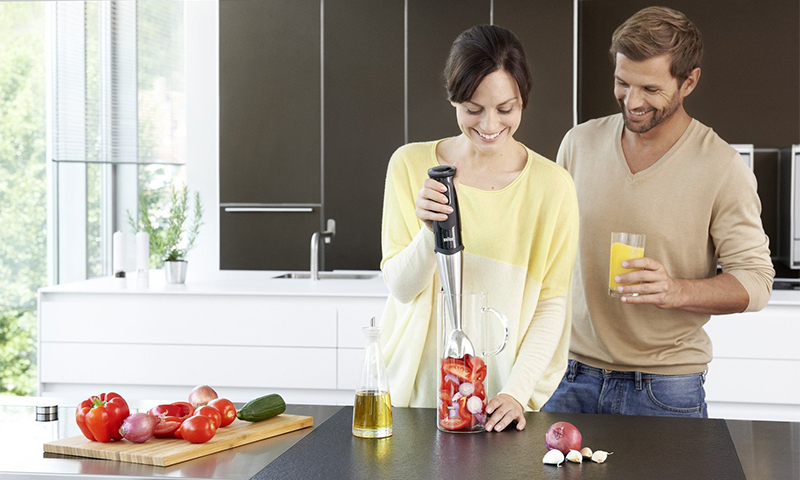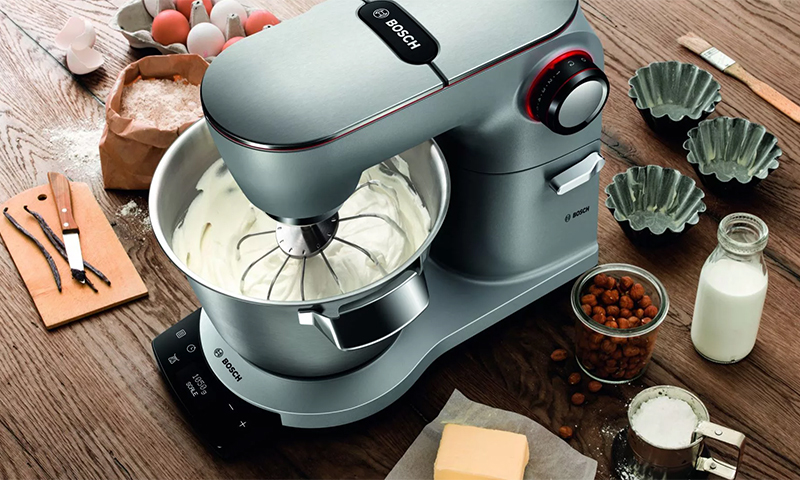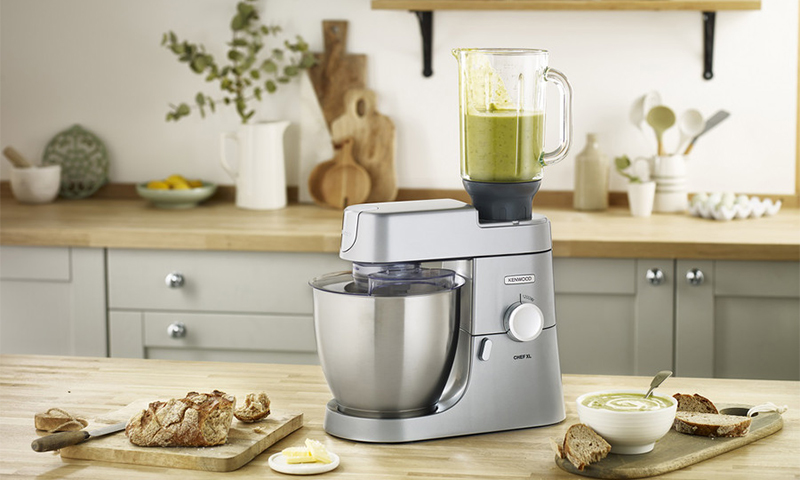Some consider the mixer a relic, mistakenly believing that it can be replaced by a blender. Meanwhile, the mixer can be an excellent kitchen assistant. It can grind fruit into puree, whip any dough, cream, or convert different ingredients into a homogeneous mixture. And if the food processor with a blender cost a lot of money, then even the “fancy” mixer will be much cheaper. Today's guide will teach you to choose this kitchen unit correctly, without overpaying for unnecessary functionality.

Content:
The best manufacturers of mixers - which company to choose
Home appliances are made by hundreds of different companies, and almost all of them have mixers in stock.
The manufacturers checked by time offer qualitative products which are made with observance of all necessary requirements. Do not be afraid if the factories of firms are located in China, and on the goods marked "Made in China". The brands that protect their reputation take strict control over the production of goods, no matter what country their assembly shops are located in.
The most popular brands today are:
1. Bosh
2. Philips
3. Moulinex
4. Tefal
5. Vitek
The listed companies have a large selection of various mixers. They differ from each other not only by price, but also by technical characteristics, functional equipment, design and many others. This allows everyone to choose the best product option for themselves. If you are interested in specific models, we advise you to contact our rated best mixers.
The principle of operation and the device mixer

A mixer is a special electrical device used to whip or mix liquid foods as well as bulk foods. It helps to cook many dishes much faster. It is usually used to make dough, pastry creams, sauces, mousses, mashed potatoes, cream and other things.
There are two types of mixers: manual and stationary. Manual consist of a small body, on which the gearshift is located, the corollas are located in the lower part. Stationary have large dimensions. The case is fixed on the stand, where the bowl, which is included in the kit, is installed. Corollas are lowered into it during operation. Some stationary models are equipped with rotating bowls, which makes it possible to use the entire capacity space where mixing or whipping takes place.
The device comes into action thanks to the engine. Maximum uniformity is achieved due to the special arrangement of the rims, which during rotation move along an intersecting trajectory. Do not confuse the mixer with a blender, as these are two completely different household devices. The blender works much faster, and is intended mainly for grinding ingredients.
Types of mixers
Stationary (household)
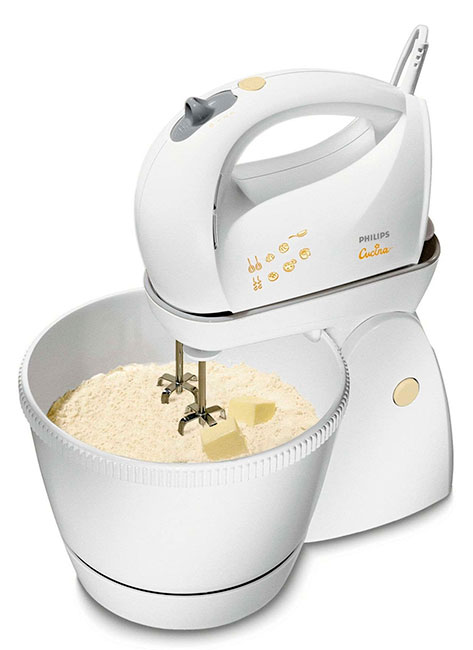
A stationary device almost does not require user intervention in the process. It is enough to hoist the bowl on the stand, fill in the necessary things in it and lower the case into which the required nozzles are inserted, and then press the switch.
Such a mixer is able to cope even with kneading a stiff dough, as it has sufficient power. And the function of bowl rotation, if any, allows the mixture to be evenly processed.
Advantages:
- powerful (400 - 700 watts);
- copes with complex dishes (thick and yeast dough);
- advanced functionality;
- does not need human control.
Disadvantages:
- large dimensions;
- engine noise and bowl rotation;
- the need to wash the tank;
- high price.
Planetary

The most powerful type of mixers. Without fail there is a function of rotating the nozzle around its axis (according to the principle of rotation of the planets) and around the entire circumference of the bowl. Thanks to this mixture it turns out perfectly kneaded, homogeneous and everything in the shortest possible time.
Such a device is suitable for those who often prepare time-consuming dishes, especially pastries and desserts. Some models can be equipped with additional devices, for example, a grater, meat grinder, etc.
Advantages:
- the most powerful (500 - 1.200 W);
- practical and functional;
- reliable and durable;
- maintains maximum loads;
- able to work on a production scale.
Disadvantages:
- large size and weight;
- high noise level;
- high cost.
Manual

Easy and simple mixer, which is suitable for whipping cream, eggs, butter and kneading semi-liquid dough on pancakes or biscuit. In the case there is a special handle, for which it is convenient to grab a mixer, to be controlled by it in the process of cooking. Easy to clean, just take out the nozzles and rinse them under water.
The device does not require much storage space and will fit in any cabinet. Make a cool dough with a hand mixer will not work, but if you are not fond of such dishes, then, without hesitation, buy such a device.
Advantages:
- small dimensions;
- low weight;
- compactness;
- ease of care;
- inexpensive.
Disadvantages:
- low power (200-500 W);
- noisy;
- during cooking must be kept in hand;
- copes only with simple tasks.
Mixer Selection Parameters
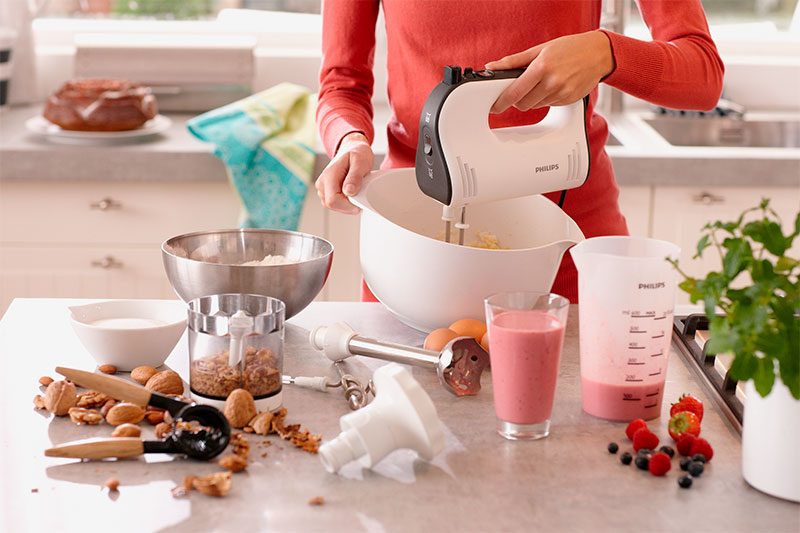
Power
First of all, when choosing a mixer, you should pay attention to its performance indicators. This characteristic is the most important, since it determines the speed with which the device will be able to process products, and performance.
High power allows the device to perform many even the most difficult tasks. But do not forget that in this case a large amount of electricity will be spent, and the cost of the device will be much higher than less powerful mixers.
1. Stationary mixers for domestic use should not have power ratings lower than 500 watts.
2. Planetary stationary mixers, which most often work on a production scale, have a capacity of at least 900 watts. A smaller load will require 600 watts of power.
3. There are enough 250 watts of power for hand-held mixers for rare applications. But if you plan to use it often, then choose a model with a value of 350 - 400 watts. Such devices are perfect for daily cooking.
Body and bowl material
Cases of hand-held and stationary mixers are usually made of plastic, but there are models of other materials. Bowls, in turn, are both metal and glass.
1. Plastic
Cheap material to reduce the cost of the entire product. Differs in ease. Poor quality can start to smell, vibrate and squeak. Plastic bowls tend to warp and change color over time.
2. Metal
Steel in the body and the bowl is found in stationary models. They are stable, and it helps to knead the dough cool. Such mixers have a presentable appearance, but the price of the devices is much higher than the plastic ones. The most practical containers are obtained from metal.
3. Glass
Usually, bowls are made of this material. They are beautiful, environmentally friendly and economical in cost, but you should be careful with them, because of their fragility it is easy to damage them.
Bowl volume
Mixers have in the set different volumes of bowls from 1 to 6 liters. This indicator should be chosen, given the amount of product that must be mixed or whipped in one go. In stationary planetary mixers, the bowls have a large volume, which, however, does not interfere with preparing small portions, since the mixing system with rotating nozzles and bowls allows it.
When choosing a container, analyze the amount of products you process, adding about 200 to 500 ml to this.This supply is necessary so that the contents do not splash out of the bowl.
If the kit comes with a special cap that has holes, then adding ingredients will become much easier. At the same time, your kitchen will be protected from stains, and you can add or pour the necessary items right in the process of the mixer.
Nozzles
Mixers can be equipped with a variety of nozzles in an amount of from one to five.
1. Corolla
With it, it is convenient to whisk a variety of products.
2. Hook
Used to knead the dough. Spiral fit for more fluid textures.
3. Paddle
Perfectly mixes batter.
4. Blender
This nozzle allows you to grind. It copes well with the preparation of smoothies, sauces, cocktails, etc.
5. Steel rod with a knife
Easily allows you to make mashed potatoes, baby formula and stuff.
Each device is equipped with an automatic separation of nozzles. At the end of the work, just press a special button. In expensive models there are limiters that fix the nozzles in the process of the mixer.
Speed modes and other functions
Mixers can have from 3 to 10 speeds. The more of them at the device, the more precisely the degree of adjustment of processing products is adjusted. It also allows you to smoothly increase or decrease the rotation of the nozzle.
Main modes:
1. Standard
Turn on for normal mixing or whipping.
2. Pulse
The motor works jerky, which is suitable for grinding products with high hardness.
3. Turbo mode
Accelerated operation of the motor for a short time, usually a few seconds. This is to prevent overheating of the engine.
You should not overpay for a large number of modes, since in practice the user usually has from 2 to 5 speeds.
The useful options include the presence of a timer that allows you to set the desired time off and on the mixer. With such work, the person will not be tied to the device, at the right time can leave. Automatic shutdown of the device in case of overheating will protect the system from failure.
Which mixer to choose
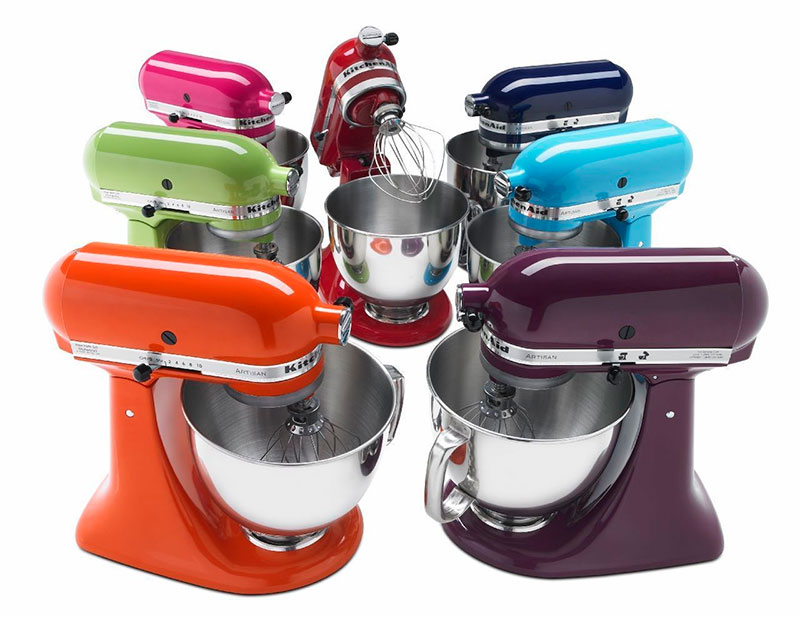
1. The hand mixer should be chosen by those who do not plan to cook complex dishes.
2. The stationary household appliance is suitable for more labor-intensive tasks, for example, for kneading tough dough.
3. The planetary type of device can be chosen if baking and pastry making is done quite often and on a large scale. This mixer will do an excellent job in a small bakery.
4. Calculate the power based on the amount of work that the device must perform.
5. Case material choose plastic or metal (for stationary mixers). It is better to take a bowl from a stainless steel.
6. The volume of the bowl is better to choose at least 2 - 6 liters. This will make it possible to cook both large and small portions.
7. Nozzles must be purchased depending on the dishes that are planned.
8. Of the additional features especially useful timer and system overheating protection.
9. For most types of work suitable devices with 2 - 5 speeds.
How much does a mixer
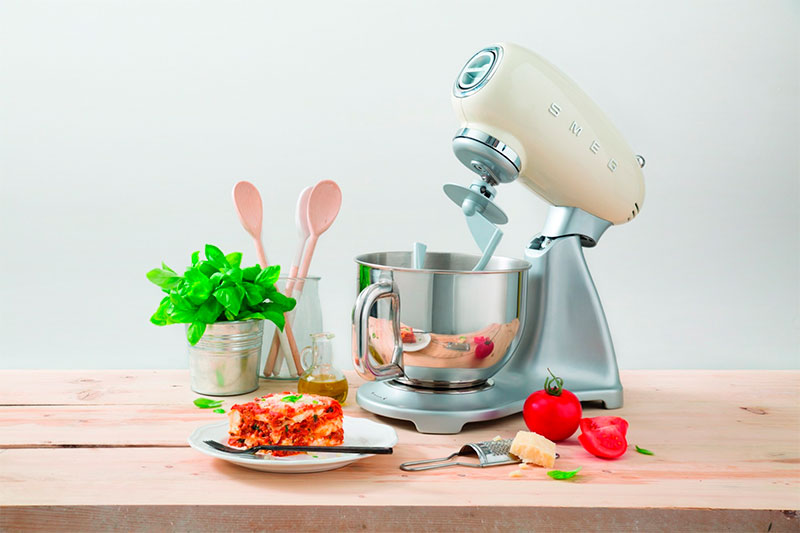
1. For a stationary mixer, you will have to pay around 3 - 8 thousand rubles.
2. Planetary cost will be even more expensive. The cost of the model can reach up to 150 thousand rubles. However, such devices are more suitable for use in production, where large-scale work. The minimum price will be around 10 thousand rubles.
3. A handheld mixer is inexpensive. The price tag on it ranges from 500 to 3 thousand rubles, depending on the brand, materials of manufacture and equipment.
It will be interesting to friends too


